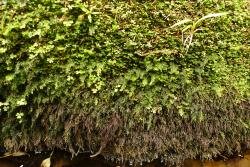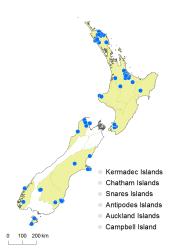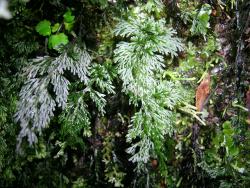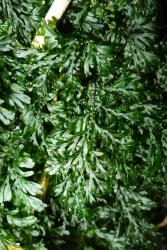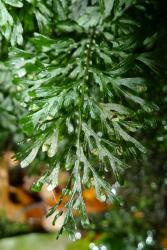- ≡ Sphaerocionium australe (Willd.) C.Presl, Hymenophyllaceae 35 (1843)
- ≡ Mecodium australe (Willd.) Copel., Philipp. J. Sci. 67: 24 (1938)
- = Hymenophyllum atrovirens Colenso, Tasmanian J. Nat. Sci. 2: 186 (1845)
- ≡ Hymenophyllum javanicum var. atrovirens (Colenso) Hook. & Baker, Syn. Fil., ed. 2. 60 (1874)
- ≡ Hymenophyllum australe var. atrovirens (Colenso) C.Chr., Index Filic. 357 (1905)
- ≡ Mecodium atrovirens (Colenso) Copel., Philipp. J. Sci. 73: 457 (1941)
- = Hymenophyllum montanum Kirk, Trans. & Proc. New Zealand Inst. 10: 394. t. 21b (1878)
- ≡ Mecodium montanum (Kirk) Copel., Philipp. J. Sci. 67: 22 (1938)
Rupestral ferns or rarely low epiphytes. Rhizomes long-creeping, 0.2–0.5 mm diameter, glabrous or bearing scattered red-brown hairs up to 0.5 mm long clustered at stipe bases. Fronds 38–210 mm long. Stipes 10–80 mm long, dark brown throughout, narrowly winged almost to the base, bearing a few scattered hairs proximally; stipe wings planate. Laminae 2–4-pinnatifid, narrowly ovate to ovate or occasionally elliptic, 24–140 mm long, 10–60 mm wide, dark green, membranous, glabrous. Rachises winged throughout, dark brown proximally, pale brown distally, glabrous; rachis wings planate or slightly flexuous. Primary pinnae in 6–15 pairs, scarcely overlapping, winged throughout; distal portion of primary pinnae incurved acroscopically; distal primary pinnae narrowly elliptic or narrowly ovate, adnate; proximal primary pinnae ovate or narrowly ovate, adnate; the longest primary pinnae at or near the base, 9–45 mm long, 6–21 mm wide. Secondary pinnae arising both acroscopically and basiscopically, slightly overlapping, winged throughout, elliptic to ovate, adnate; the longest secondary pinnae 5–12 mm long, 1–7 mm wide. Ultimate lamina segments oblong or linear, up to 5 mm long, 0.4–1.0 mm wide; apices obtuse or truncate or emarginate; margins entire, sometimes with an indistinct thickened border; distal segments on primary pinnae often curved towards frond apex. Sori borne on short acroscopic and basiscopic segments throughout pinnae, solitary or in pairs, many on each primary pinna, adnate; indusia bivalvate; indusial flaps triangular or ovate or sometimes elliptic, 0.75–2 mm long, apices usually acute or sometimes obtuse or truncate, margins slightly toothed or bifid; receptacles included within indusial flaps.
Hymenophyllum australe is a small to medium-sized filmy fern distinguished by its narrowly ovate frond, planate wings on the stipe, and habitat on rocks in or near streams. It can be distinguished from other species with winged stipes by its creeping rhizome (cf. erect rhizome in H. pulcherrimum), indusial flaps lacking crests (cf. crested indusial flaps in H. sanguinolentum), planate stipe wings (cf. flexuous wings in H. flexuosum), and smaller lamina (30–140 mm long, 10–60 mm wide cf. 60–430 mm long, 40–170 mm wide in H. dilatatum and H. flexuosum). Hymenophyllum australe is most easily confused with H. pluviatile but can be distinguished by its distinctive habitat (cf. epiphytic, terrestrial or rupestral in H. pluviatile), its less divided frond (2–4-pinnatifid, cf. 4–5-pinnatifid), stipe wings which are broader and extend almost to the base, primary pinnae which tend to be curved acroscopically rather than straight, and ultimate lamina segments which are curved towards the frond apex rather than divergent, and are often emarginate rather than obtuse or truncate.
North Island: Northland, Auckland, Volcanic Plateau, Gisborne, Taranaki, Southern North Island.
South Island: Western Nelson, Canterbury, Otago, Fiordland.
Stewart Island.
Altitudinal range: 30–850 m.
Hymenophyllum australe has been sporadically recorded in the North Island from Northland, Mt Pirongia, the Kaimai Ranges, Rotorua district, Lake Waikaremoana, Pureora, Egmont National Park and the Akatarawa Ranges, and in the South Island from north-west Nelson, north and inland Canterbury, Banks Peninsula, Lake Wakatipu, Dunedin and two localities in Fiordland. It also occurs on Stewart Island. It is apparently absent from much of the west coast of the South Island. In the North Island it ranges from 120 m up to 850 m on Mt Pirongia, and in the South Island from 30 m to 550 m on Mt Burnett and Banks Peninsula, and to over 600 m at Morrison’s Creek, Dunedin.
Also Australia (Queensland, New South Wales, Victoria, Tasmania).
In New Zealand Hymenophyllum australe is restricted to a very specific habitat, usually growing on rock, or rarely low on tree trunks, in and around flowing water in shaded habitats. It can grow partially submerged or just above the level of flowing water, on boulders in stream beds, beside waterfalls or in seepages. In Australia the species grows in a wider range of habitats, extending to rock away from water, and as an epiphyte.
Hymenophyllum australe (as atrovirens) was given a conservation status of Naturally Uncommon by de Lange et al. (2013).
n = 36 (Brownlie 1965).
This species was previously known as H. atrovirens and considered endemic to New Zealand (Allan 1961; Brownsey et al. 1985; Brownsey & Smith-Dodsworth 2000). However, recent revisions (Ebihara et al. 2010; Perrie et al. 2013) have shown that the New Zealand plants are conspecific with H. australe, previously considered endemic to Australia.
H. atrovirens was described by Colenso (1845) from collections he made on the shores of Lake Waikaremoana in December 1841. The lectotype was chosen by Allan (1961), citing "Colenso, 1841" in WELT (now WELT P003267). There is also a specimen at K (Colenso 275) which, although labelled "Bay of Islands" in Hooker’s hand-writing, was probably collected on Colenso’s journey through the Urewera district in 1841 and could be a syntype (photo WELT E468/12).



